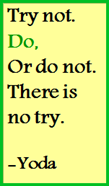 What comes to mind when you hear the words “vision” or “mission”?
What comes to mind when you hear the words “vision” or “mission”?
Do you think first of an insightful mystical or religious experience? Perhaps the word conjures up the image of a fortune teller gazing into a crystal ball to discern her patron’s foretold future. Or perhaps you think of a wise guru sitting atop a mountain, handing down life-changing counsel to a spiritual pilgrim.
Following are three examples of people I have worked with recently who are struggling to create a new vision for their lives:
Sally is a woman in her seventies who is looking for what’s next in life. She has learned that it’s important to have purpose, and if she can find a purpose that involves serving others, she can bring more joy and happiness to herself. How can she find a purpose that serves her?
Kelly is a woman in her forties who is going through the divorce of a marriage that she’s worked really hard to save. She has experienced a lot of chaos in her life, but has never learned how to utilize tools to plan and manage her life. She is constantly in a state of reaction and regularly experiences overwhelm and some depression. The sense of chaos continues. She feels at a loss for what to do about various aspects of her life such as how to create an adequate income for her family and make a decision on where to live.
Sam is a man in his eighties who lost his wife five years ago. He is still in the yearning stage of grief and going through his transition. He hasn’t yet opened himself to what his new beginning could be.
For all three people, the question is how to craft a vision – a strong enough vision – one that they are willing to take the necessary risks for and the actions to manifest it. None of these people will be able to manifest a vision without some level of risk, but I believe all would agree that the risk would be worth it if it means living a joyful, fulfilling and satisfying life on purpose.
When it comes to creating a vision or mission for one’s life, I suggest that instead of thinking of prophecies handed down to us by others, we instead picture this:
You.
- Sitting at a potter’s wheel.
- Engaging your mind in creativity.
- Getting your hands dirty in the clay.
- Physically shaping the clay to resemble the picture in your mind [your vision].
- Walking away with something very real that will be put into service for many years to come.
Unfortunately, some people languish in creating their vision. They have the dream of what they want, but they don’t know how to manifest it. Using our example of the potter, here’s what that would look like:
You.
- Thinking about sitting at a potter’s wheel.
- Thinking about how wonderful it would be to express your creativity.
- Keeping your hands clean.
- Creating nothing.
- Walking away with nothing.
How do we implement a vision for our lives?
Implementing a vision [or mission] for one’s life requires action on three things:
1. Craft a compelling vision: what do I wish/want to create in my life? What do I want my life to be?
2. Embody the vision: make the declaration “This is what I wish/intend to create in my life”
3. Take action to manifest the vision: move past the limiting mindsets that may be holding you back from enacting your life plan.
How do we craft a vision for our lives?
The answer to this question starts with two questions:
Have you outlined the criteria for what you want in your life?
Have you placed this set of criteria in rank order according to what is important to you?
The life planning processes that I have applied in my life has seven categories:
1. What do I wish to create in health?
Physical, emotional, spiritual, intellectual growth and lifelong learning, and playing.
Why play? Because it’s important to feel like life isn’t just work and that you can have joy in what the world brings to you.
2. What do I wish to create in my relationship with my children?
How do I want to show up for my children? How do I want to provide them with love, nurturing and support?
3. What do I want to create in my relationship with my spouse/significant other?
For many people this would be number two. In my situation, because my wife passed away at 39 my relationship with my children became my second highest priority.
4. What do I want to create in my friendships?
It’s important to create and maintain friendships that can and will show up and provide support through the tough times.
5. How do I wish to create an income?
For true happiness and fulfillment, it’s extremely important to discover what your natural gifts and talents are, be creative in your gifted area, and implement your creations in a place that has values compatible with your own.
6. What do I wish to create financially?
For what purpose do you want money? Lots of money can be nice, but I have watched people die getting rich, and they are unable to spend it from the coffin. Others have made lots and lots of money at the expense of good relationships with their loved ones. I measure my life by the quality of the relationships that I have, not by the amount of money I have created.
7. Where do I want to give back and be of service in my community?
It turns out that having a purpose of service to others makes a big difference in your personal joy, happiness, and satisfaction. As I have gotten older I have realized that being of service is even more important.
Reflect on the seven categories in this list and rank them in priority order according to what will help you live a fully engaged life.
How do we embody our vision in a way that will clear the path to action?
After crafting the idea of what we want to create we must declare it. We must state what we are going to make happen. Declarations make the vision real because they transfer what’s in the mind to action in the body. They are choices we have the authority and power to exercise.
Read and reread your statement of what you want to create, then meditate about it or visualize it. The mind can’t distinguish the difference between the real and the imagined. This successful practice is not a new idea. It was first brought to my attention in the book Psycho Cybernetics by Dr. Maxwell Maltz.
How do I take action on my vision?
No amount of creating and holding a vision does you any good if you don’t take action. Think back to our example of the potter. What good does it do to simply think about sitting at a potter’s wheel?
Continue on the path to your life purpose by reading my blog series on taking action: “Forget Visioning, Let’s Take Action”
What if I decide that the vision I created for myself doesn’t fit anymore?
Certainly, as life unfolds for you, as it did for Sally, Kelly and Sam, the vision may need to change. Make peace with that fact.
Children grow up and leave.
Loved ones die.
Some marriages end in divorce.
Relationships break up.
Jobs are lost.
Health suffers.
And just like the potter sitting at the wheel, you will continue to shape and reshape the clay – your life’s vision – until your creative vision is achieved once again.
Now it’s your turn.
What do you hope to create in your life?
How would a clear vision, declared and held within you help you live your life on purpose?
What roadblocks are present in your life that stand between you and taking the action required to live a fully engaged life?
What actions do you need to take to move forward?



2 Comments
Sue Rivera · August 1, 2014 at 4:28 am
I love reading these!
Larry Freeborg · September 2, 2014 at 2:25 pm
Thanks for your comment. I’m glad you enjoy reading my blogs. Your positive feedback is really appreciated.
Comments are closed.